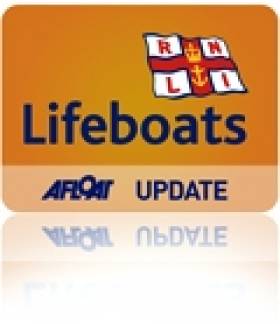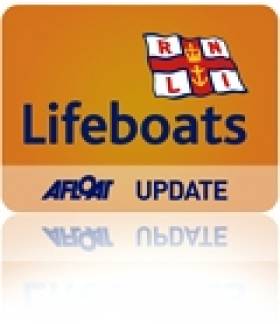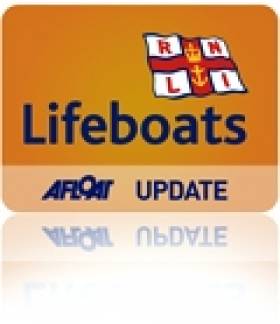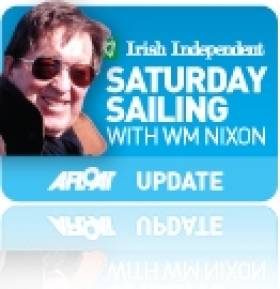Displaying items by tag: Courtmacsherry
#Lusitania100Cork – This May, four coastal communities in Co. Cork are coming together to host a series of commemorative events, entitled Lusitania100 Cork, to mark the centenary of the sinking of the RMS Lusitania by a German U-boat off the coast of Cork, Ireland, during the First World War. The Lusitania was en route to Liverpool from New York and 1,201 people lost their lives in the tragedy.
Kinsale, The Old Head, Cobh and Courtmacsherry in Co. Cork, in association with Cork County Council, will pay tribute to all those who lost their lives in 1915 and remember the gallant efforts of their ancestors who responded with great courage and compassion to rescue survivors, the bereaved, and recover the dead, in ordinary fishing boats and lifeboats. These communities witnessed first-hand the trauma and heartbreak of the disaster.
The Old Head of Kinsale is the point from which the Lusitania took her final bearing on 7th May 1915 and is the most prominent accessible point of land to the ship's final resting place, which is just over eleven miles due south of the Old Head Lighthouse.
The old British Royal Navy Watch Tower of the Seven Heads peninsula in Courtmacsherry Bay is the closest point of land to the Lusitania wreck, and also home to the oldest RNLI Lifeboat Station in Ireland, which was instrumental in the aftermath of the disaster.
The mass grave at the Old Church Graveyard on the Great Island of Cobh was the final resting place of the dead, and to this day there are remains that have never been named or claimed.
The commemorations for Lusitania100 Cork are vast and will include Wreath Laying Ceremonies with President Michael D. Higgins in Cobh, and Minister Simon Coveney at the Lusitania Monument on the Old Head, both at 2.10 pm on May 7th, the time the tragedy happened.
A number of re-enactments of the tragedy will also take place. Courtmacsherry will recreate the call to service of the RNLI lifeboat, while Cobh will remember their rescue efforts with a twilight Flotilla of work boats, fishing boats and pleasure craft, each illuminated with white lights. Cobh will also re-enact the Mass Funeral procession, and Kinsale town is recreating the aftermath Inquest with descendants of the 1915 Jury.
The Old Head Signal Tower (and the associated Flag- and –Ball signalling system), is being restored and transformed into a Lusitania Museum, with plans to exhibit artefacts recovered from the wreck. This will be officially opened on May 7th. Eventually the Museum will also host an iconic piece of sculpture with the names of all who sailed on the Lusitania on May 7th 1915. A new Lusitania Exhibition will also open at the Queenstown Story at Cobh Heritage Centre from March 25th.
In addition, all four communities will host Lusitania related lectures, talks, photographic exhibitions, memorabilia and street fairs, and centenary commemoration dinners. A free open air tribute concert encompassing music from Cork's Harbour will also take place on Cobh's Promenade on May 7th, a perfect vantage point to view the twilight Flotilla.
Kinsale History Society and Port of Cork have both launched schools initiatives, encouraging primary and secondary students to study Lusitania and submit Lusitania projects, essays and art for display at the Temperence Hall in Kinsale town Centre and Cobh Maritime Building over the commemoration week.
Courtmacsherry:
Friday 1st May
• 7.45pm - Fly-over of Irish Coast Guard Helicopter
• 8pm - Official Opening of Centenary Weekend by Mr Simon Coveney, T.D., Minister for Agriculture, Marine & Food (and Defence) on Courtmacsherry pier. Teas / coffees available in Community Hall.
• Ryder and Courtmacsherry RNLI Lifeboats on display.
• 6 – 9pm - Lusitania Exhibitions in RNLI Lifeboat Station and Community Hall showing artefacts, memorabilia and story boards.
Saturday 2nd May
• 11am – 9pm – Daily Lusitania Exhibitions in Lifeboat Station and Community Hall. Model Exhibition at St. John the Evangelist Church.
• Lusitania themed talks in Blind Strand and Butlerstown. Bus transport arranged from village. Short Stories in Bars and Café's throughout the day. See local notice boards for further details.
• 2 – 5.30pm - Ryder and Courtmacsherry Lifeboats alongside pontoon on pier for public viewing.
• 5.30pm - Pulling and Sailing Lifeboat display with restored Ryder Lifeboat.
• 8.00pm - Lusitania lecture and presentation by esteemed Lusitania author and diver Paddy O Sullivan in Community Hall.
Sunday 3rd May – Main Event - Re-Enactment of Lifeboat Callout
• 11.00am - Events at Blindstrand across from the Old Lifeboat Station in Barry's Point. Buses arranged for transport from RNLI Lifeboat Station in Village. Narration of the RNLI Lifeboat call to Service.
• Lifeboat Launch. Start re-enactment of 12 mile Lifeboat row to Lusitania tragedy
• Lusitania themed talks in Blind Strand and Butlerstown. Bus transport arranged from village.
• 11.00am–9pm – Daily Lusitania Exhibitions in Lifeboat Station and Community Hall. Model Exhibition at St. John the Evangelist Church of Ireland.
• 3.30pm – Lusitania Presentation in Community Centre by renowned Lusitania Diver Eoin McGarry.
• Short Stories in Bars and Café's throughout the day. See local venues for details.
• 8.00pm - Return of "Ryder" lifeboat to Courtmacsherry Pier after completion of row to site of Lusitania (Exact arrival time dependent on weather conditions).
Monday 4th May
• 11am – 5.00pm - Lusitania Exhibitions in Lifeboat Station and Community Hall. Model Exhibition at St. John the Evangelist Church of Ireland.
• 2 – 5.00pm - Ryder and Courtmacsherry RNLI Lifeboat alongside pontoon on pier for public viewing.
Wednesday 6th May
• 8pm – Lusitania Centenary Commemoration Black Tie Dinner at Courtmacsherry Hotel. Special Guest speakers include Lusitania owner and renowned Lusitania technical diver. Tickets cost 85 each. Limited availability. See our website for further details.
Thursday 7th May – Centenary day
• 9.30am Morning Commemoration mass at Sacred Heart Church, Courtmacsherry
• 2.10pm - Wreath Laying at exact site of Sinking of RMS Lusitania by RNLI Courtmacsherry Lifeboat. Release of 1201 balloons by local school children each one bearing the name of a Lusitania victim.
Cobh:
April:
Throughout April there will be a series of free lectures in Cobh as well as screenings of films and documentaries relating to Lusitania. These are as follows:
• Monday 6th: Ray White - The making of the documentary "Death by misadventure" & John Hennessey - "The Queenstown Lifeboat station" 3 pm Commodore Hotel
• Sunday 12th: Michael Martin "Lusitania - It wasn't and it didn't" 3.30 pm Commodore Hotel – after the annual Cobh Titanic Commemoration
• Sunday 19th: Eoin McGarry "Diving the Lusitania" 3 pm Commodore Hotel
• Sunday 26th : Paddy Sullivan "The sinking of the Lusitania, Unravelling the Mysteries" 3pm Commodore Hotel
Thursday 7th May:
All visitors and locals are requested to enter into the spirit of the day and dress in outfits of the era when coming to these events.
• 7am: Queen Victoria 'Lusitania Remembered' themed cruise arrives at Cobh Cruise Terminal.
• All day:
o Photographic Exhibit in the Cunard Building
o Port of Cork School Initiative projects on display in Cobh Maritime Building,
o Lusitania Exhibit at the Queenstown Story in Cobh Heritage Centre
o New Lusitania Exhibition entitled 'Lusitania – A Day in May' at Cobh Museum, housed in the former Scots Presbyterian Church.
o Lusitania Exhibition at Sirius Arts Centre – the exhibition will consider and link together three characters that died on-board the Lusitania - Corkman Sir Hugh Lane, and Americans Elbert Hubbard and Alice Hubbard. Lane was best known as a renowned art collector and Director of the National Gallery of Ireland, Elbert Hubbard was a writer, publisher and social agitator and Alice Hubbard was a writer and feminist. The Hubbards were also founders of the Roycroft Arts and Crafts Community and movement in New York State. The movement had a strong influence on the development of American architecture and design in the early 20th century. The exhibition will take the form of a number of portraits of all three characters (painting and photographs) and a text-based installation by writer and poet Sheila Mannix.
o Make sure you visit The Lusitania Peace Memorial in Cobh, which epitomises the efforts made by people to rescue survivors, recover bodies and comfort the bereaved. Irish American Sculptor Jerome Connor was commissioned by Bert Hubbard to sculpt a memorial to the tragedy. This is one of the most photographed objects in Cobh.
• 10am: A special commemorative mass will be held in St Colman's Cathedral, Cobh. Especially welcome will be relatives of those who died in the sinking of the Lusitania, relatives of those involved in the rescue efforts and relatives of survivors. Immediately afterwards there will be an opportunity for everyone to attend an informal gathering in Cobh Parish Centre which is adjacent to the Cathedral and to sign a special book of remembrance.
• Special mass in St. Coleman's Cathedral for families and friends of survivors, those lost and the brave local people who came to their aid. All welcome.
• 11am: Cobh Museum in association with Cobh Library, will host a Lecture by historian Giollamuire O Murchu entitled: Siochain Ainm De/ And all her paths are peace – American Angels, Irish Rescuers: The true story of the Lusitania Peace Memorial 1925-1968.
Graveyard Ceremony – Old Church Graveyard
• 12pm: Wreath laying ceremony at the graves of Lusitania victims takes place at Old Church graveyard with Chairman of Cunard and Chairman of Port of Cork.
Main Ceremony – Promenade
• 1pm: Performance by Band 1 Southern Brigade.
• 1.15pm: President Michael D Higgins Arrives.
• 13.35pm: Ceremony commences.
• 2.10pm – 2.30pm:
o Queen Victoria will sound a whistle to mark the moment Lusitania was hit by the torpedo, and a Naval vessel at anchor off the Promenade will respond.
o This will be followed by a minutes silence and blessings, and hymns by Ryan Morgan, Amanda Neri and Joe Corbett with Concert Orchestra.
o The Queen Victoria will then sound a second whistle to mark the sinking of Lusitania, and again the Naval vessel will respond, and there will be another minutes silence.
o The Captain of Queen Victoria will recite 'Ode of Remembrance.
Wreath Laying Ceremony – Lusitania Monument, Town Square
• 2.35pm: Wreath laying ceremony by President Higgins and British, German and US Ambassadors. This will end the official commemoration.
• 2.45pm – 4.15pm: Musical performances will take place on the Main Stage in the Promenade by Ryan Morgan, Amanda Neri & Joe Corbett with Concert Orchestra.
• 3.00pm: Professor Angela John, Historian will give a talk in Cobh Library - A Survivor's Story: Margaret Haig Mackworth & the Sinking of the Lusitania
• 4.00pm: Dr John Borgonovo, School of History, UCC will give a talk in Cobh Library - Lusitania, Cork Harbour and the Underwater War, 1914 – 1918
• 6.30pm: Queen Victoria departs Cobh
• 8-10pm: A free open air musical tribute concert encompassing music from Cork's Harbour will take place in Cobh's Promenade to set the tone and give the perfect vantage point to view the Flotilla at 9.15pm. Music from Ireland and America will date from the period and there will also be a range of sea shanties of the era.
• 9.15pm: A Flotilla of work boats, fishing boats and pleasure craft, each illuminated with white lights, will sail from Roche's Point towards Cobh. The boats will re-enact the rescue efforts and symbolise the return to Cobh on 7th May 1915 of boats filled with victims and survivors. The use of searchlights and white lights will provide a poignant and memorable spectacle from many varied vantage points and will allow local communities along the Cork coastline, including Fort Camden and Whitegate to have their own tributes and ceremonies.
• 9.45pm: Grand Finale of all the contributors to this Centenary Commemoration on the main stage in the Promenade.
• 9.30pm: Boat carrying the Cunard Flag comes ashore & The Procession of Light from Kennedy Pier in the Centre of town to the main stage in the Promenade with the bells of Cobh Cathedral ring out across the harbour. The illumination of the Lusitania Monument.
Sunday 10th May
• All day: Photo Exhibition at Cunard Building, Lusitania Exhibit at Queenstown Story.
• 12.00pm: A special commemorative mass will be held in St Colman's Cathedral, Cobh to mark the anniversary of the funeral procession for Lusitania victims on May 10 1915.
• 3.00pm: A re-enactment of the funeral procession to the Old Church Cemetery from the centre of Cobh to the Old Church Cemetery where the victims are buried. It is intended to replicate the funeral as closely as possible to the funeral order that was in 1915 with the general public invited to dress in clothes of the era. An ecumenical ceremony will be held in the Cemetery.
Monkstown:
• 7.00pm: Monkstown Chamber Choir are having a special Evensong in St. John's Church Monkstown to commemorate the tragedy of the Lusitania. This will be attended by cadets from NMCI.
Old Head
Thursday 7th May
• 1.15pm: Public assembly at the Lusitania monument on the Old Head of Kinsale.
• 1.40pm: Arrival of coastguard Air Sea rescue helicopter. Courtmacsherry 1915 replica lifeboat will also be at the Old Head Signal Tower.
• 1.45pm: Arrival of Guests and Simon Coveney T.D.
• 1.50pm: Speakers and Platform Party assemble.
• 2.00pm: Introduction and Welcome by Raymond White, Master of Ceremonies.
• 2.00pm: Courtmacsherry lifeboat over wreck site. Courtmacsherry 1915 replica lifeboat at the Old Head Signal Tower.
• 2.10pm: 1 minute silence.
• 2.11pm: Ecumenical prayer service followed by laying of wreaths at the monument.
• 2.20pm: Lament specially composed by Linda and Irene Buckley.
• 2.25pm: Last post on bugle.
• 2.28pm: Address by:
1. Alan Coleman, County Mayor
2. Michael Dowe, Grandson of Lusitania Captain Dowe
3. Historian
4. Stuart Williamson, Artist
5. Simon Coveney T.D. Minister of Agriculture, Food, Marine & Defence
• 2.45pm: Unveiling of commemorative plaque by Minister Coveney.
• 3.00pm: Official Opening of the Old Head Restored Signal Tower (and the associated Flag- and –Ball signalling system), which is being restored and transformed into a Lusitania Museum, with plans to exhibit artefacts recovered from the wreck. Eventually the Museum will also host an iconic piece of sculpture with the names of all who sailed on the Lusitania on May 7th 1915.
• 3.30pm: Irish Coastguard helicopter will open to public. The Signal Tower will also open to the public. From the parapet walkway the full panorama of one of Ireland's most scenic peninsula's will unfold.
Kinsale
Wednesday 6th May:
• 6.00pm: Lectures at the Speckled Door, organised by Bandon & Kinsale History Societies.
Thursday 7th May:
• 10.30am: Lusitania Town Walk from the Tourist Office
• 2.10pm: Minute silence in all schools in Kinsale while church bells ring, and the release of 1200 balloons.
• 5.00pm: Mr Simon Coveney T.D., Minister for Agriculture, Food, Marine & Defence will meet decedents of the 1915 Jury for re-enactment by Kinsale College Drama Students/ Kinsale Rampart Players. (Numbers limited.)
• Time TBC: Launch of Lusitania stamps at Kinsale Post Office.
Friday 8th May:
• 11am-1pm: Drama at the Kinsale Community School followed by drama at Naomh Eltin N.S. for 6th class primary pupils.
• 3.00pm: Official opening of the Federation of History Societies Conference in the Trident Hotel.
• 7.30 -8.30pm: Commemorative Concert in St. Multose Church with History Society, Lydian singers, KAOS, and the RNLI and local clergy to include inquest re-enactment by Kinsale College Drama students/ Kinsale Rampart Players, ecumenical prayers and wreath-laying.
• 9pm: Opening of the annual conference of the Federation of History societies with dinner and keynote speech by Greg Bemis.
• The Creation of Lusitania Exhibition highlighting the story of the Lusitania and relevance of Kinsale in the subsequent inquests will be showcased in the Kinsale Museum.
Saturday 9th May:
• 10.30am-1.30pm: AMG of the Federation at Trident Hotel
• 2pm-4pm: Street Fair organised by the Kinsale Good Food circle, Market Quay, with the Animation group from Cobh.
• 3pm-5.30pm: Lusitania Seminar with speakers from the U.S. UK and Ireland, followed by visit to the Signal Tower at the Old Head.
• 10am-6pm: Local schools art and project exhibition at the Kinsale Temperance Hall. Courtesy of Courtmacsherry RNLI at the 1915 lifeboat will be on exhibition in Kinsale.
Sunday 10th May
• 10am-6pm: Local schools art and project exhibition at the Kinsale Temperance Hall.
Sunday 24th May
• Sea Sunday, an annual event that commemorates those who were lost at sea and prays for the safety of those out at sea, will take place in St. Multose Church with access to a rescue boat from Courtmacsherry. This will be followed by a wreath laying ceremony and a parade to the Seaman's Memorial on Kinsale Pier.
Courtmacsherry Lifeboat Completes 11 Hour Rescue of 120–Ton Fishing Vessel
#rnli – The Courtmacsherry RNLI All Weather Lifeboat was called out at 10.40 am yesterday morning to go to the aid of a 90ft–fishing vessel that had got into difficulties while fishing 35 miles off the Coast of Seven Heads in West Cork and sought assistance.
The Lifeboat with a crew of 7 Volunteers were underway within minutes and headed to the scene of the casuality which was due south of the Old Head of Kinsale, beyond the Gas Fields. The Lifeboat located the Fishing Boat drifting at 12.20pm and took the boat , with its crew of five, in tow. After a six and a half hour tow in moderate force 4/5 conditions, the Lifeboat completed the berthing of the 120 Tonne stricken vessel at the pier in Union Hall. The lifeboat has now returned to its base in Courtmacsherry and the crew have returned to their homes after an eventful day.
The Courtmacsherry RNLI Lifeboat Operations Manager, Brian O Dwyer praised the quick response this Sunday morning of the voluntary Lifeboat crew from all walks of life and work, who carried out the day long rescue in a well drilled and skillful manner.
They were at sea for nearly 11 hours in total. Of interest as well is the fact the The Courtmacsherry Lifeboat held its first ever joint exercise with the newly formed RNLI Inshore Lifeboat Station at Union Hall only yesterday. The crew on todays call out were Coxswain Mark Gannon, Mechanic Chris Guy and Crew, Dave Philips, Dean Hennessy, Billy O Donovan and the father and son team of Micheal and Ciaran Hurley.
Courtmacsherry Completes 31–Mile Tow of Broken Down Fishing Vessel
#rnli – The Courtmacsherry RNLI Lifeboat completed its tow of the 33 ft–Fishing Vessel 'Michelle' back to the pier in Courtmacsherry after earlier today going to its rescue 31 miles offshore near the Kinsale Head Gas Fields.
The four hour tow was conducted in good conditions and both the two crewmembers and stricken boat are now docked at village pier.
On board the Courtmscsherry RNLI Lifeboat on today's Callout were Coxswain Sean O Farrell , Mechanic Stewart Russell and crew Ciaran Hurley, Ken Cashman, Gary Barrett, Kieran Boyle and Orla Cronin.
Courtmacsherry Lifeboat Tows Kinsale Passenger Vessel with 30 Onboard Back to Shore
#rnli – Courtmacsherry RNLI All Weather Lifeboat was called out at 12.36 this afternoon to go to the aid of a 46 ft Passenger Pleasure boat which encountered difficulties off Kinsale Harbour by Charles Fort. The Lifeboat with a crew of seven were underway immediately and together with the Kinsale RNLI Inshore Lifeboat reached the scene quickly.
The casualty boat had ropes entangled in its props and had lost power near the shoreline. Both Lifeboats have now succeeded in towing the Casualty back to Kinsale and it is now safely docked there. There were approx 30 passengers on board the passenger pleasure boat today when it got into difficulties. The conditions at sea today were strong winds blowing Force 6/7.
Belgian Schooner Crew Rescued By Courtmacsherry Lifeboat
#lifeboat – The Courtmacsherry RNLI Lifeboat has now completed its rescue of the Stricken 66 Ft Belgium Yacht "Tom" that sought help at 3.20pm this afternoon 23 miles south east of Courtmacsherry Bay. The Lifeboat took the casualty in tow at 4.20pm and has now berthed the large Schooner at the Courtmacsherry Pier. The Yacht was on passage from Newlin in Cornwall to Ireland when it's engines failed.
All 5 crew on the yacht were relieved to be on land in Courtmacsherry tonight. Lifeboat Operations Manager Brian O Dwyer was high in praise of the quick response of Acting Coxswain Kevin Young and his crew of Six in the very smooth rescue of this large vessel today.
Crew on today's Callout were Coxswain Kevin Young, Mechanic Stewart Russell and crew Micheal Hurley, Ciaran Hurley, Mark John Gannon, Dave Philips and Dean Hennessey.
#RNLI - A fishing vessel that developed steering trouble in Belfast Lough was towed to safety by Donaghadee RNLI’s all-weather lifeboat Saxon, assisted by Bangor RNLI’s inshore lifeboat.
The Donaghadee lifeboat launched at 3.20pm yesterday (Friday 9 May) after a request from Belfast Coastguard.
At the scene, six miles north-east of Orlock Point, a secure tow-line was established to the stricken trawler, which had a crew of six.
The vessel was towed to Bangor Harbour where the crew of Bangor’s Atlantic class lifeboat Jessie Hillyard assisted, safely guiding the trawler to a berth at the Eisenhower Pier. The Donaghdee lifeboat stood down at 5.40pm.
Donaghadee RNLI’s lifeboat operations manager Alan Couser said: “This rescue was a fine example of swift action and good teamwork by two lifeboat crews. Another potential tragedy has been averted.”
Elsewhere, a 75-foot fishing boat St Claire was finally towed to safety in Cork Harbour by the Courtmacsherry lifeboat last night after a marathon 11-hour operation.
As previously reported on Afloat.ie, the vessel had got into difficulties earlier in the day some 35 miles off the West Cork coast.
Poor sea conditions with strong winds resulted in a slowed return journey to shore.
Courtmacsherry RNLI deputy launching authority Dermot O'Mahony said: "All aboard the trawler were mighty pleased to be in safe harbour tonight.
"I would like to commend the volunteer lifeboat crew on their quick response for what has turned out to be a lengthy call-out."
The lifeboat crew on yesterday's call-out were coxswain Sean O 'arrell, mechanic Stewart Russell and crew Dara Gannon, Ken Cashman, Gary Barrett, Ciaran Hurley and Dave Philips.
#lifeboat – Courtmacsherry RNLI All Weather Lifeboat continues to tow a 75–foot fishing vessel that had got into difficulties earlier today 35 miles off Courtmacsherry in West Cork. It is now proceeding to take the trawler to the safefy of Cork Harbour. As the conditions at sea today are poor with strong winds, it will be 7.30 pm this evening before both vessels arrive at the mouth of the Harbour. Following the successful location of the stricken Trawler at 10 am this morning, both vessels are making slow pace in poor conditions. There are six crew on board the fishing vessel.
#lusitania – The Courtmacsherry Lifeboat Lusitania Centenary Committee is appealing to anyone or any organisation that may have Lusitania artefacts, stories and memorabilia or know of any family members of those lost or saved in the tragedy to get in contact.
Next Wednesday 7 May, marks the 99th anniversary since the sinking of the Lusitania and Courtmacsherry RNLI's lifeboat will be visiting her resting place to lay a wreath to remember those lost.
The RMS Lusitania was a British ocean liner, launched in 1907 by the Cunard line, a holder of the Blue Riband and briefly the world's biggest ship. On 7 May 1915 on passage from New York, she was torpedoed and sunk by a German U-boat South of Courtmacsherry Bay, West Cork, Ireland with the tragic loss of over 1,200 lives.
Shortly after she was hit, Courtmacsherry RNLI's lifeboat, Ketzia Gwilt which was then stationed at Barry's Point under the command of Coxswain Timothy Keohane and his crew of 14 men, was requested to respond to reports of a large four funnel steamer in distress south east of the Seven Heads.
Courtmacsherry's lifeboat was launched, but in calm conditions without any wind, the sails were of no use so the entire distance of over 12 nautical miles to the casualty had to be rowed by the lifeboat crew.
Next year, to commemorate the centenary of the sinking, the crew of Courtmacsherry RNLI will perform a re-enactment of their call to service on that tragic day in 1915 and will row out to the site of the disaster in a restored original pulling and sailing lifeboat from 1900.
This commemoration event will be held during the May Bank holiday weekend and will be accompanied by a Lusitania exhibition in the lifeboat station and other related events at local venues.
Tadgh MacCarthy, Courtmacsherry RNLI second mechanic and committee member said: 'My ambition to join the lifeboat crew came at a very young age, shaped by the stories that my grandmother told me of watching the Lusitania sinking from the school yard in Butlerstown. As I grew older this enthusiasm also grew so eventually I followed in my grandfather and grand uncle's footsteps and joined the lifeboat crew to keep the tradition of providing help to those in need at sea.'
Dara Gannon from the Courtmacsherry Lifeboat Lusitania Centenary Committee added: 'The loss of the Lusitania is a huge part of Courtmacsherry history and it's not long since some retired lifeboat crew from that day in 1915 were around to recall it. Every Courtmacsherry crew member today holds admiration for all the hardy crewmen of long ago that responded in the attempts to rescue life that tragic day and hope that this centenary commemoration not only makes people think of the loss of life but also the gallant efforts made to save it.'
Anyone with information, questions or contributions are asked to email [email protected] or contact the station at +353 23 8846600. If you would like to learn more about Courtmacsherry RNLI Lifeboat's call to the sinking of the Lusitania, please visit our website at www.lusitaniacentenary.ie
Irish Cruising – Sailing's Magic Elixir for a Long Life
#cruising – Cruising is the hidden side of sailing, yet it's the choice for the majority of those going afloat. Whether it's day cruising, a longer venture in the annual holidays, or the dream cruise of a lifetime across oceans, this is our sport. Unlike racing, which generates its own narrative even if only through the recorded results, much of cruising would slip under the radar completely were it not for cruising awards. W M Nixon considers the latest annual batch from the Irish Cruising Club.
Cruising under sail seems to be the secret of eternal youth. Last night's Annual General Meeting of the Irish Cruising Club in Dun Laoghaire saw a distribution of awards to voyagers from all parts of Ireland who sailed successfully in many areas of the globe in boats mostly of modest size. Yet any outside analyst would soon have made the point that many of the achievers were of mature – sometimes very mature - years, and fulfilling a retirement dream.
But despite any ICC membership gathering these days being a sea of silver heads, age is the last thing they think about. This club of 550 members has become the mixture of an Active Retirement Association – very active indeed, as it happens – and a sort of seagoing extension of the Men's Shed movement.
If you were looking for an illustration of Ireland's changing demographics, and our very rapidly changing attitude as to what constitutes old age, you need look no further than the ICC. Time was when it was thought quite something when one of the club achieved the Golden Jubilee of their membership. But these days, it's no big deal to have been on the strength for fifty years, as the senior member is Joe FitzGerald of Crosshaven, who this year marks 70 years in the club, and he is closely followed by Douglas Mellon who joined in 1947 from Howth - he now lives on the Scottish Riviera in Kircudbright.
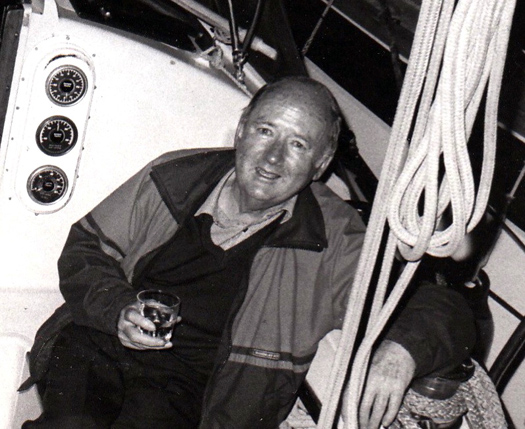
Joe FitzGerald of Cork is the ICC's most senior member, having joined in 1944. He served as Commodore from 1984 to 1987.
All those years ago when they took up their membership, it was thought perfectly normal for young men – married or otherwise - to take off for at least a fortnight's cruising every year, regardless of family demands which these days would be regarded as the prior commitment. In fact, nowadays so much emphasis is placed on family life and families doing just about every last recreational thing together, that younger married sailing people either do extremely short-hop cruising of the type necessitated by catering for the needs of all the members of the family, or else they don't cruise at all in the traditional sense - "Fun For All The Family" effectively rules out proper cruising.
Then too, modern life has so many other distractions - not least of them work demands which involve 24/7 attention - that the old-style easygoing simply-wandering-along holiday cruising is very much a minority activity. This means that at first it seems young people are not taking up traditional cruising at all. But with its deep experience garnered since its foundation in 1929, the Irish Cruising Club has learned to take the long view. It is not unduly concerned by the steadily rising age profile of its membership, and certainly every year there is a significant group of sometimes quite senior yet nevertheless increasingly active cruising enthusiasts joining the club.
They're the embodiment of the slogan that Sailing is a Sport for Life, and it's only politeness which prevents them saying that the subtle pleasures of cruising are wasted on the young. So when you look at the lineup of achievement represented by last night's awards, it's natural to wonder what these people did in earlier life, that they can nowadays afford the time, resources and dedication necessary to complete voyages of this quality.
The adjudication was done by Dave Whitehead of Kinvara on Galway Bay, himself no stranger to the ways of the sea while making long voyages in small craft. He breaks new ground by awarding three trophies at once to Sam Davis of Strangford Lough, whose Cape Horn and Pacific ventures with his Rival 41 Suvretta have been quietly bubbling away in the background of ICC activity for the past three years.
Sam Davis first featured in Afloat magazine in March and April 1981 when we ran his two-part account of his first ocean voyage, an Atlantic circuit from Strangford Lough between 1976 and 1979 with the 34.5ft West Solent Class Suvretta, a former racing boat he'd found in a derelict state and restored to ocean-going condition.

The 34ft West Solent class Suvretta in her offshore racing days in the 1950s when she was based in Belfast Lough. When Sam Davis did the Atlantic Circuit cruise with her in 1976-79, she carried a less loft mainmast, with masthead rig.
But even with Sam's improvements, she was still no more than a slip of a boat, so it says much for his grit and skill that he brought her through the Fastnet storm of 1979 as he sailed the final hundred miles back to Ireland. There was damage aloft, and he'd to get into Dunmore East unaided with jury rigging, but the job was done.
While in the Caribbean, he'd worked in charter yachts between times to make a shilling or two. But after he'd spent time back in Northern Ireland, he went abroad into serious seafaring in offshore service industries, working in places like The Gulf, the North Sea, the Amazon, the Red Sea and Malaysia, becoming a fully accredited Marine Consultant.
Yet if you ask him nowadays what he is and what he was, he'll say he's a farmer and former seaman, as his purchase some years ago of Conly Island in Strangford Lough (you can drive out to it when the tide is down) gives him the little bit of land, and an anchorage too, while "seaman" covers his many experiences in offshore work.
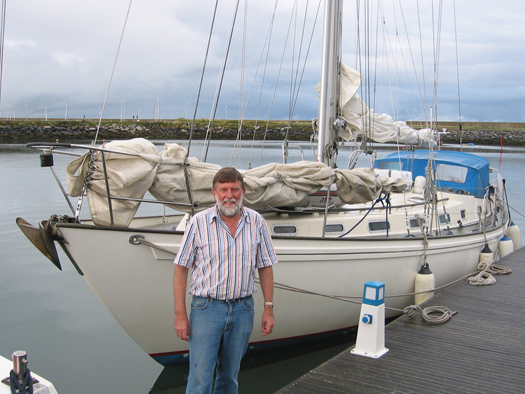
Sam Davis with his newly-acquired Rival 41, re-named Suvretta, in 2009. Photo: W M Nixon

Suvretta in the Beagle Channel in southern Chile. Photo: Sam Davis
Back in 2009 he bought a Rival 41, a hefty and able vessel, a sister-ship of Waxwing in which fellow ICC members Peter and Susan Gray of Dun Laoghaire went round the world 14 years ago. Sam re-named his new boat Suvretta, spent the winter sorting her out, and in 2010 he was gone, sailing south single-handed to eventually round Cape Horn and then spend a long time on the coast of Chile. He was delayed there as a ship broke drift and damaged the boat, but it was well fixed, and he voyaged on into the Pacific to many islands, including Pitcairn and the Tahiti group.
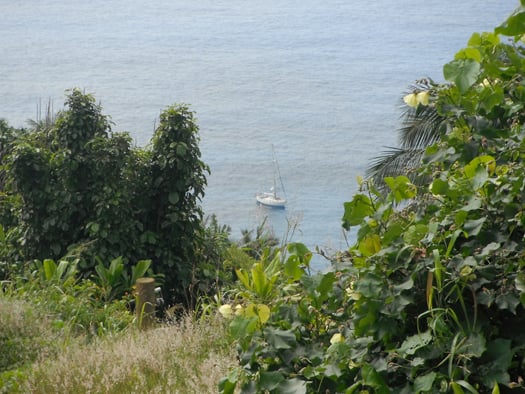
Restless anchorage. Suvretta in Bounty Bay on Pitcairn Island. Photo: Sam Davis
Eventually he fetched up for some time in Tonga, where he became enthused about the 73ft Vakas, the Pacific islanders' contemporary take on the classic Polynesian inter-island vessels (see Sailing on Saturday 11th January 2014). But by November 2012 it was time to head for home, so Suvretta sailed southeast for Cape Horn non-stop, and having rounded it, shaped her course for Port Stanley in the Falklands.
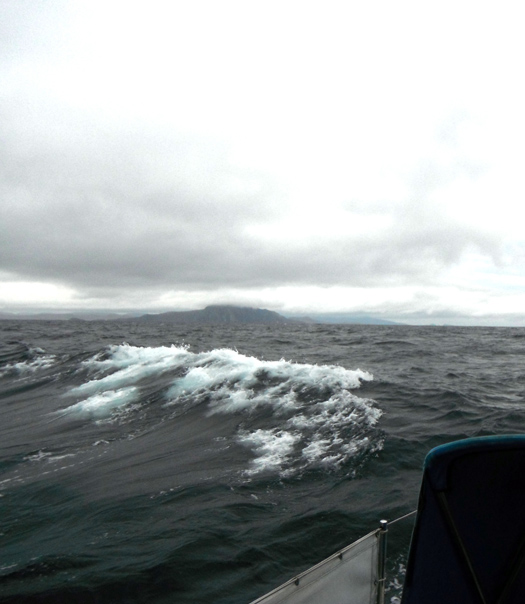
Suvretta rounding Cape Horn for the second time, 21st January 2013. It was only when the Horn was well astern that the weather deteriorated rapidly to make for a challenging approach to Port Stanley. Photo: Sam Davis
However, while rounding the Horn had been simple enough, the passage onwards to Stanley became increasingly fraught, running before rising storm force winds. Conditions were such that it looked for a while as though the lone sailor was going to be swept right past the islands, but he made the cut into shelter to such a nicety that he is awarded the ICC's Rockabill Trophy for Seamanship.
And then when Port Stanley was reached, a very fine passage had been completed from Tonga, so last night for that he was additionally awarded the ICC's Atlantic Trophy for the best voyage with a non-stop leg of more than a thousand miles. And then finally, after they'd spent the mid part of 2013 working their way up the Atlantic with the lone skipper particularly enjoying himself at ports on the Irish coast, Suvretta and Sam returned after three years to Conly Island. And they'd now done more than enough to also be awarded a third trophy - the ICC's premier honour, the Faulkner Cup.
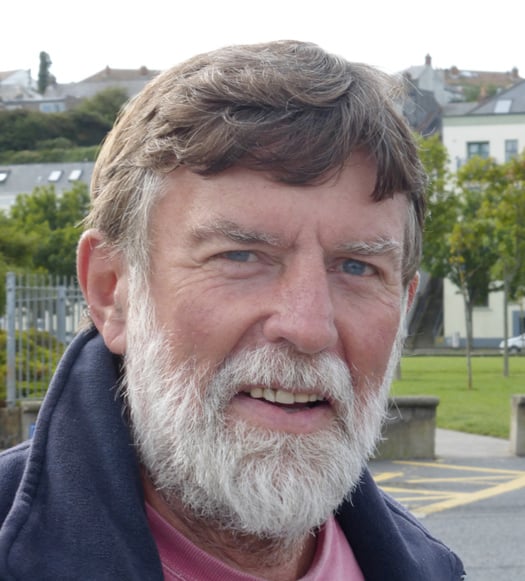
Home again. Sam Davis back in Ireland, August 2013. Photo: W M Nixon
With such a high level of activity by many members, ICC adjudicators always find some final choices to be a very close call, so some years ago the Strangford Cup was inaugurated for the cruise which almost won the Faulkner Cup. This year it has gone to a fine cruise from Portugal to Madeira and through the Azores in detail before returning to Portugal.
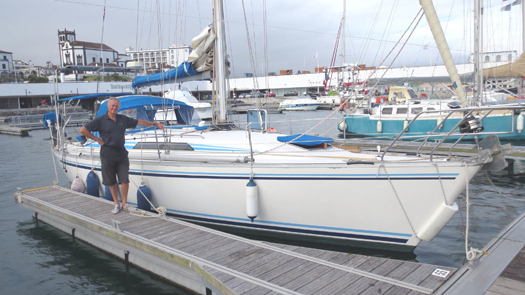
John Duggan with his MG CS40 Hecuba in Horta in the Azores
John Duggan originally hailed from Malahide where he sailed, and he also sailed with the college teams while at Trinity College in Dublin. He cruised and raced offshore mostly in the Irish Sea, but having qualified as an accountant he decided to spread his wings internationally, and he became one of those key people who turn up as partners in one of the big four accountancy firms worldwide.
Eventually his career brought him to the company's offices in Lisbon. Living in Portugal suited him fine, so he put down roots and in time bought himself an interesting cruiser. Hecuba is a 1989 Canadian-built Tony Castro-designed MG CS40, a handsome 12m craft with good performance enhanced by an effective wing keel.
During his final years in the day job he gradually improved the boat with a mind to some proper cruising once he retired at 60, something which he planned with all a high-powered accountant's meticulous attention to detail. He remembers the final day at the office, when a friend on the other side of the world sent him an email: "Even the worst day of your retirement will be better than the best day at work".

Azorean whaleboat with Pico beyond seen during one of Hecuba's cruises from Portugal to the Azores. Photo: John Duggan
Maybe so, yet not everyone makes the changeover smoothly, but in John Duggan's case the challenge of planning and executing remarkably civilised yet challenging cruises has proven to be a complete new job in itself, but much more fun than number crunching. He goes to enormous trouble to make sure that his crews have as enjoyable and varied an experience as possible, yet all the time he is quietly keeping the project moving along while noting details and features of ports visited which might be of interest to fellow skippers, a habit which is the hallmark of the true cruising man.
When you live in Cascais with your boat based in the marina nearby, the Azores are the western isles which call you each summer. But unlike Scotland's Western Isles which are just a day's sail away across the Sea of the Hebrides, the Azores involve an immediate ocean voyage from Portugal of at least 500 miles. However, for 2013's cruise west, Hecuba made it a triangle, going first to Madeira before going on nor'west to the Azores which were cruised in detail before returning to Cascais after six weeks away, having logged 2390 miles, with the final tabulation being:
Hours spent close hauled: Zero.
Cross words exchanged: Zero.
Inevitably the two big awards dominate the scoresheet, but the ICC also has a host of trophies which reflect every level of club sailing activity. The Round Ireland Cup, for instance, is for the circuit which produces most information for the club's sailing directions, and in a year in which a goodly number went round, it was Donal Walsh of Dungarvan with his Moody 31 Lady Kate who best filled the bill.

Donal Walsh's Lady Kate anchored at Inishmurray off the Sligo coast during his detailed round Ireland cruise. Photo: Donal Walsh
As the Faulkner Cup was first won in 1931 by the 28ft cutter Marie, the Marie Trophy is for the best cruise by a boat under 30ft, and Mick Delap from Valentia Island with his Tamarisk 24 gaff cutter North Star fits into the size requirement with six feet to spare. He made a fine job of completing a two-summer circuit of Ireland by returning from western Scotland via the Irish Sea and Ireland's south and southwest coasts.

Mick Delap's Tamarisk 24 North Star from Valentia in Lowlandman's Bay in Jura in the Hebrides. Photo: Mick Delap
In all, the ICC has a dozen cruising trophies. But even so not everyone gets one in a typically busy year, so to encourage the newcomers they've the Perry Greer Trophy for first time log-writers, and it goes to Peter Mullan from the Quoile in Strangford Lough for his insightful account of a round Ireland cruise with the Jeanneau Sun Odyssey Sancerre.
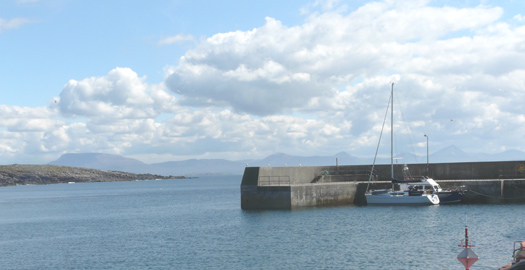
Peter Mullan's Sun Odyssey Sancerre in the little harbour at Tory Island with the Donegal highlands beyond. Photo: Peter Mullan
All the logs, including the winning ones, were featured in the ICC's 180-page Annual 2013, which Honorary Editor Ed Wheeler managed to get to the members in time for Christmas. All this is done by voluntary effort, yet the Annual would stand up to professional comparisons, as it includes informative accounts of cruises in just about every part of the world, plus a report on the ICC Cruise-in-Company to the Isles of Scilly which was an outstanding success despite coinciding with some uneven weather in June.
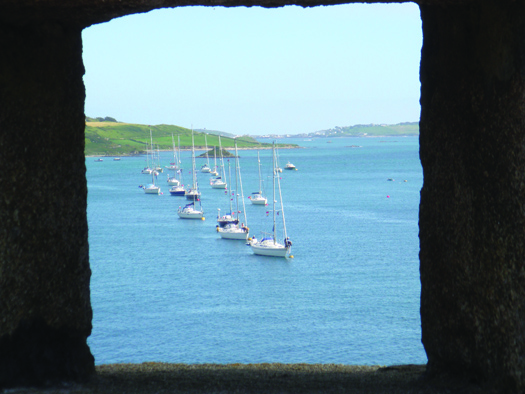
The Irish Cruising Club flotilla in the Isles of Scilly during their successful Cruise-in-Company in June 2013.

Everyone to his taste. ICC member Brian Black went to Greenland for the sixth time, crewing on Aurora. This is Kangertitiatsivaq Fjord in high summer. Photo: Brian Black
There's more to the Club than the Annual, as the ICC's programme of producing constantly up-dated Sailing Directions for the entire Irish coast in two volumes is a continuous progression, with the latest 12th Edition of the North & East Coast Book due next month from Honorary Editor Norman Kean, whose home port is Courtmacsherry.
Thus it's clear that Ireland's cruising club is a truly all-Ireland organisation, and this year it will be celebrating its 85th birthday with a Cruise-in-Company to Glengarriff where it was founded on July 13th 1929. Yet despite its obvious significance, this is a club without premises. In the final analysis, it's a club of the mind, made up of kindred spirits. Heading such a body is a mighty challenge, and the changing of the watch is always a charged moment.
Last night David Tucker of Kinsale stood down after serving his three years as Commodore, and he was succeeded by Peter Killen of Malahide. His experience in club administration is long-lived – he was Commodore of Malahide YC when it became "Club of the Year" in 1980. But it was his cruising CV which next went into overdrive, as in 1993 he voyaged north to Iceland, circled it, and then sailed back in near-record time in an S&S 30. He then moved up to a Sigma 36 which he cruised to Greenland among other places, following which he cruised even further with a Sweden 38, and then in 2004 he took on his dreamship, the Amel Maramu 54 Pure Magic.
Peter Killen seems to have cruised this very special boat just about everywhere. Not least was deep into Antarctica, where he made a memorable arrival in zero visibility with icy conditions into the natural harbour in the extinct volcanic crater on Deception Island. It was all a long way in time and distance from five boats gathered in Glengarrif in the hope of forming a little cruising organisation back in 1929. But that's the way it is with the Irish Cruising Club.
Courtmacsherry Crowned Coastal Rowing Champions
#AllIrelandCoastal: Courtmacsherry were deemed Simply the Best as they won the big one, the senior men’s title, at the All-Ireland Coastal Rowing Championships at Carnlough in Co Antrim today. Ring took second place. The senior ladies title was retained by Cairndhu, with Ring again second.
All-Ireland Coastal Rowing Championships, Carnlough, Co Antrim (Selected Results)
Men
Senior: 1 Courtmacsherry, 2 Ring, 3 Kilmacsimon
Intermediate: 1 Passage West, 2 Arklow, 3 Carnlough
Junior: 1 Workmens, 2 Cairndhu, 3 Ring
Under-21: Courtmacsherry
Open Classic: 1 Castletownbere, 2 Cairndhu, 3 Carnlough A
Cork Yawl: 1 Whitegate, 2 Passage West, 3 Rushbrook.
Heritage: 1 St Patrick’s A, 2 St Patrick’s B, 3 St Michael’s
Masters: 1 Passage West, 2 Whitegate
Pre Vet: Courtmacsherry.
Veteran: 1 Portmagee, 2 Passagewest
Under-16: Passage West
Women
Senior: 1 Cairndhu, 2 Ring, 3 Kilmacsimon
Fisa Doubles: Arklow. Fisa Singles: 1 Arklow A , 2 Cairndhu, 3 Arklow B.
Open Classic: 1 Cairndhu, 2 Castletownbere, 3 Carnlough A.
Intermediate: 1 Cairndhu, 2 Portmagee, 3 East Ferry
Cork Yawl: 1 East Ferry, 2 Passage West, 3 Whitegate
Heritage: 1 Killurin, 2 St Kerin’s, 3 St Michael’s
Under-21: 1 Ring, 2 Portmagee, 3 Galley Flash
Under-18: Portmagee
Junior: 1 Courtmacsherry, 2 Templenoe, 3 Arklow
Masters: 1 Galley Flash, 2 Kilmacsimon, 3 Rushbrooke
Pre Vet: Cairndhu A
Mixed
Senior: Fossa
Vet: Cairndhu





























